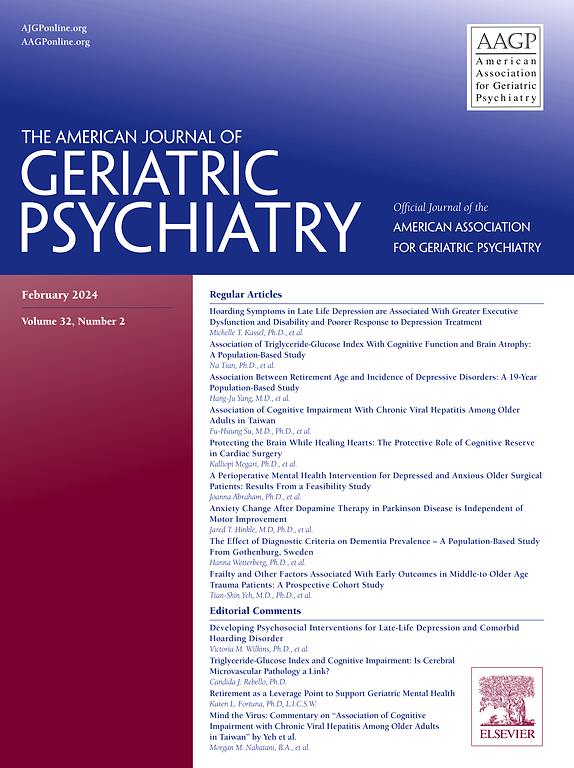衰老、额颞叶痴呆和阿尔茨海默氏症患者脑电图的 Beta 与 Theta 熵比。
IF 4.4
2区 医学
Q1 GERIATRICS & GERONTOLOGY
引用次数: 0
摘要
背景:衰老、额颞叶痴呆症(FTD)和阿尔茨海默氏痴呆症(AD)表现为脑电图(EEG)的改变,尤其是线性功率谱密度(PSD)得出的β-θ功率比。鉴于大脑的非线性特性,脑电图的非线性特征可以为衰老和认知障碍提供有价值的生理指标。多尺度离散熵(MDE)是一种敏感的非线性指标,可用于评估脑电图在生物相关时间尺度上的信息含量:比较 MDE 导出的 beta 与 Theta 的熵比及其基于 PSD 的对应指标,以检测健康的年轻人和老年人之间以及不同痴呆亚型之间的差异:头皮脑电图记录来自两个数据集:1)老年数据集:2)痴呆数据集:29名年龄匹配的健康对照组(HC)、23名FTD患者和36名AD患者。对这两个数据集进行了基于 MDE 与 PSD 的β-θ 比率分析。最后,还探讨了 HC、FTD 和 AD 患者的认知表现与β-θ比率之间的关系:结果:在老龄化数据集中,老年人的β-θ熵比明显高于年轻人。在痴呆症数据集中,该比率在区分HC、FTD和AD方面优于β-θ PSD方法。痴呆症患者的β-θ熵比明显低于FTD患者,尤其是在颞区,这与基于PSD的相应比率不同。β-θ熵比与认知能力有明显的相关性:我们的研究采用非线性 MDE 对脑电图进行分析,引入了β-θ熵比,突出了其作为衰老和认知障碍的敏感生物标志物的潜力。本文章由计算机程序翻译,如有差异,请以英文原文为准。
Beta-to-Theta Entropy Ratio of EEG in Aging, Frontotemporal Dementia, and Alzheimer's Dementia
Background
Aging, frontotemporal dementia (FTD), and Alzheimer's dementia (AD) manifest electroencephalography (EEG) alterations, particularly in the beta-to-theta power ratio derived from linear power spectral density (PSD). Given the brain's nonlinear nature, the EEG nonlinear features could provide valuable physiological indicators of aging and cognitive impairment. Multiscale dispersion entropy (MDE) serves as a sensitive nonlinear metric for assessing the information content in EEGs across biologically relevant time scales.
Objective
To compare the MDE-derived beta-to-theta entropy ratio with its PSD-based counterpart to detect differences between healthy young and elderly individuals and between different dementia subtypes.
Methods
Scalp EEG recordings were obtained from two datasets: 1) Aging dataset: 133 healthy young and 65 healthy older adult individuals; and 2) Dementia dataset: 29 age-matched healthy controls (HC), 23 FTD, and 36 AD participants. The beta-to-theta ratios based on MDE vs. PSD were analyzed for both datasets. Finally, the relationships between cognitive performance and the beta-to-theta ratios were explored in HC, FTD, and AD.
Results
In the Aging dataset, older adults had significantly higher beta-to-theta entropy ratios than young individuals. In the Dementia dataset, this ratio outperformed the beta-to-theta PSD approach in distinguishing between HC, FTD, and AD. The AD participants had a significantly lower beta-to-theta entropy ratio than FTD, especially in the temporal region, unlike its corresponding PSD-based ratio. The beta-to-theta entropy ratio correlated significantly with cognitive performance.
Conclusion
Our study introduces the beta-to-theta entropy ratio using nonlinear MDE for EEG analysis, highlighting its potential as a sensitive biomarker for aging and cognitive impairment.
求助全文
通过发布文献求助,成功后即可免费获取论文全文。
去求助
来源期刊
CiteScore
13.00
自引率
4.20%
发文量
381
审稿时长
26 days
期刊介绍:
The American Journal of Geriatric Psychiatry is the leading source of information in the rapidly evolving field of geriatric psychiatry. This esteemed journal features peer-reviewed articles covering topics such as the diagnosis and classification of psychiatric disorders in older adults, epidemiological and biological correlates of mental health in the elderly, and psychopharmacology and other somatic treatments. Published twelve times a year, the journal serves as an authoritative resource for professionals in the field.

 求助内容:
求助内容: 应助结果提醒方式:
应助结果提醒方式:


